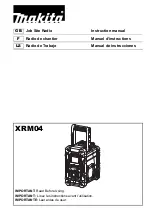
TO 31R2-2TRC207-1
6-3
c.
Verify the green LED on Radio B receiver-transmitter is illuminated and the green LED on Radio A
receiver-transmitter is not illuminated.
6-2.5
Fault LED.
The red FAULT LED (2, Figure 4-1) on the front panel is illuminated either 1) when the power amplifier temperature is
excessive, 2) if there is an RF path fault (the BDR or diplexer is cabled incorrectly, the diplexer is tuned incorrectly, or
frequency spacing is less than the recommended minimum), or 3) Radio A has a fault or there is no radio in the Radio A
sleeve. A thermistor in the power amplifier will trigger the fault indication when the internal temperature of the power
amplifier reaches 90E C (194E F). Power amplifier current draw is decreased slowly until the temperature decreases to
approximately 80E C (176E F).
6-3
SERVICING.
6-3.1
Servicing Intervals.
Table 6-4 provides recommended service intervals.
Table 6-4. Recommended Service Intervals
Recommended Interval
Task
D
W
M
Q
Visual inspection (see paragraph 6-3.2)
X
Preventive maintenance:
Inspection (see paragraph 6-3.3.1)
X
Cleaning (see paragraph 6-3.3.2)
X
D =
Daily
M =
Monthly
W =
Weekly
Q =
Quarterly
6-3.2
Inspection.
Many potential or existing faults can be detected by making a visual inspection of the equipment. For this reason, a visual
inspection should be made on a routine basis or whenever the bi-directional repeater is inoperative.
NOTE
If any discrepancies are observed, return the unit to higher level maintenance.
At a minimum, the following items should be inspected by the operator.
a.
Inspect the equipment covers and front panel for condition of finish and panel markings.
b.
Inspect for dents, punctures, and warped areas.
c.
Inspect external surfaces for loose or missing screws or washers.
d.
Inspect the receptacles and connectors for condition of pins, contacts, and mounting.
e.
Inspect the antenna for signs of physical damage.
f.
Inspect the knobs and switches for mechanical integrity.
g.
Inspect LEDs for dust accumulation.
6-3.3
Preventive Maintenance.
The bi-directional repeater requires very little routine maintenance other than inspection and cleaning. The operator shall
perform the following procedures at the intervals recommended in Table 6-4.
Summary of Contents for AN/TRC-207
Page 10: ...TO 31R2 2TRC207 1 viii This page left blank intentionally ...
Page 13: ...TO 31R2 2TRC207 1 1 1 Figure 1 1 Radio Set AN TRC 207 Sheet 2 of 3 ...
Page 30: ......
Page 53: ...TO 31R2 2TRC207 1 5 5 Figure 5 2 Repeater Control Audio CCA A1A2 Functional Block Diagram ...
Page 68: ......
Page 73: ...TO 31R2 2TRC207 1 7 5 HOW TO USE THE ILLUSTRATED PARTS BREAKDOWN ...
Page 74: ...TO 31R2 2TRC207 1 7 6 HOW TO USE THE ILLUSTRATED PARTS BREAKDOWN ...
Page 75: ...TO 31R2 2TRC207 1 7 7 This Page Left Blank Intentionally ...
Page 77: ...TO 31R2 2TRC207 1 7 9 Figure 7 1 Radio Set AN TRC 207 Sheet 2 of 2 ...
Page 81: ...TO 31R2 2TRC207 1 7 13 Figure 7 2 Bi Directional Repeater Assembly 4101027 501 Sheet 1 of 3 ...
Page 82: ...TO 31R2 2TRC207 1 7 14 Figure 7 2 Bi Directional Repeater Assembly 4101027 501 Sheet 2 of 3 ...
Page 83: ...TO 31R2 2TRC207 1 7 15 Figure 7 2 Bi Directional Repeater Assembly 4101027 501 Sheet 3 of 3 ...
Page 86: ...TO 31R2 2TRC207 1 7 18 This Page Left Blank Intentionally ...
Page 87: ...TO 31R2 2TRC207 1 7 19 Figure 7 3 Power Amplifier Assembly 15W SS 4100853 501 ...
Page 94: ...TO 31R2 2TRC207 1 8 2 ...
Page 95: ...TO 31R2 2TRC207 1 8 3 8 4 blank Figure 8 1 Radio Set AN TRC 207 Interconnection Diagram ...
Page 96: ......
Page 98: ......
















































